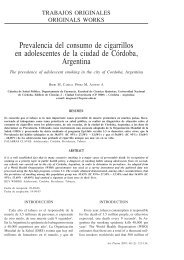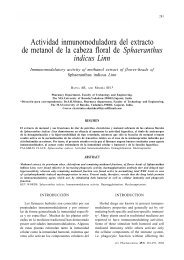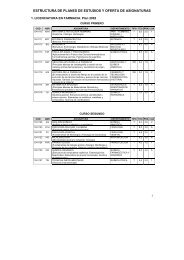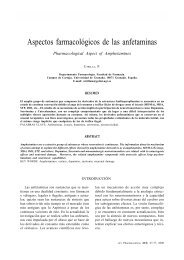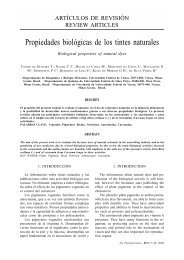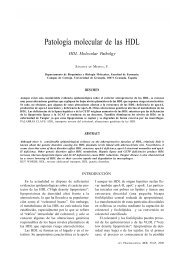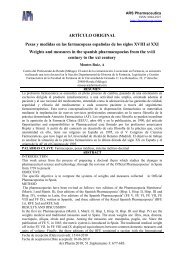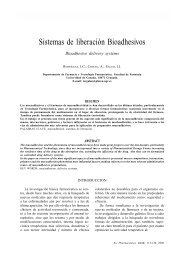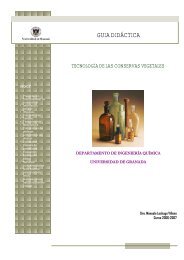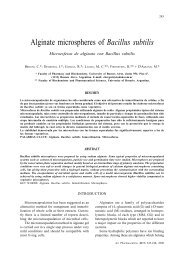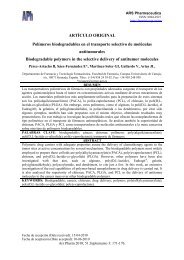Identificación in silico, caracterización molecular y análisis de ...
Identificación in silico, caracterización molecular y análisis de ...
Identificación in silico, caracterización molecular y análisis de ...
Create successful ePaper yourself
Turn your PDF publications into a flip-book with our unique Google optimized e-Paper software.
76<br />
cei se aisló med<strong>in</strong>ate métodos estándar15 . Seguidamente,<br />
se realizó la PCR utilizando ADN<br />
<strong>de</strong>l genoma <strong>de</strong> T. brucei como plantilla y oligonucleótidos<br />
P1Tb5 (5´CAAGGATCCA-<br />
AACATG ATG ATGATCGAGGTGCAAC3´) ATG<br />
y P1Tb3<br />
(5´TCTCTAGAATTTGCCCTCTA CTA CTACCCA-<br />
CTA<br />
CGACCG 3’), que se encuentran, respectivamente,<br />
al pr<strong>in</strong>cipio y al f<strong>in</strong>al <strong>de</strong>l gen codificante<br />
para la proteína PFR3 <strong>de</strong> T. brucei y<br />
contienen respectivamente los codones <strong>de</strong> <strong>in</strong>icio<br />
y parada (letras en negrita). El fragmento <strong>de</strong><br />
ADN amplificado se aisló y se caracterizó<br />
mediante el mapa <strong>de</strong> restricción y secuenciación<br />
tras su clonaje en el vector pGEM-T<br />
(Promega).<br />
Análisis Análisis Análisis Análisis Análisis Northern Northern Northern Northern Northern blot: blot: blot: blot: blot: El ARN total <strong>de</strong><br />
T. brucei se aisló mediante reactivo TRIzolR (Invitrogene). Se fraccionaron por tamaño 5<br />
µg <strong>de</strong>l ARN total en gel <strong>de</strong> agarosa-formal<strong>de</strong>hído<br />
al 1% y se transfirieron a una membrana<br />
<strong>de</strong> Z-probe (BioRad) mediante una solución<br />
<strong>de</strong> NaOH <strong>de</strong> 50 mM. Se amplificó mediante<br />
PCR un fragmento <strong>de</strong> ADN <strong>de</strong> 1,063 kb<br />
correspondiente a los nucleótidos 418 a 1481<br />
<strong>de</strong>l gen PFR3 <strong>de</strong> T. brucei, se marcó radiactivamente<br />
con [a-32P] dCTP (Fe<strong>in</strong>berg, 1983)<br />
y se empleó como sonda. Como control <strong>in</strong>terno<br />
se utilizó la sonda 18S, correspondiente a<br />
un fragmento <strong>de</strong> ADN <strong>de</strong> la subunidad pequeña<br />
<strong>de</strong> ARNr <strong>de</strong> T. cruzi 18S (Marañon et<br />
al. 1998). La hibridadción para el <strong>análisis</strong> <strong>de</strong>l<br />
nivel <strong>de</strong> expresión <strong>de</strong> los ARNs correspondientes<br />
se realizó durante 16 horas 42 ºC y<br />
37 ºC con, respectivamente, la sonda homóloga<br />
y heteróloga en formamida al 50% (v/v),<br />
5x SSC (1x SSC es 0,15M NaCl/0,015 M citrato<br />
sódico, pH 7.0), 0,2% SDS, 1x Denhart´s,<br />
0,05 M Na HPO /NaH PO tampón y 0,25mg<br />
2 4 2 4<br />
ml-1 <strong>de</strong> ADN <strong>de</strong> esperma <strong>de</strong> arenque. Se realizaron<br />
cuatro lavados tras la hibridación en<br />
2x SSC/0,1 % SDS a temperatura ambiente<br />
durante 5 m<strong>in</strong>utos y en 0,1x SSC/0,1% SDS<br />
(p/v) a 55 ºC durante 30 m<strong>in</strong>utos.<br />
3. RESULTADOS Y DISCUSIÓN<br />
Búsqueda Búsqueda Búsqueda en en la la base base base <strong>de</strong> <strong>de</strong> <strong>de</strong> datos datos datos <strong>de</strong> <strong>de</strong><br />
<strong>de</strong><br />
PFR3 PFR3 <strong>de</strong> <strong>de</strong> T. T. T. T. T. brucei: brucei brucei brucei brucei Se realizó un <strong>análisis</strong><br />
BLAST <strong>de</strong> la base <strong>de</strong> datos <strong>de</strong> T. brucei <strong>de</strong>l<br />
NCBI utilizando como sonda la región <strong>de</strong><br />
Ars Pharm 2005; 46 (1): 73-84.<br />
MORELL M, GARCÍA-PÉREZ JL, THOMAS MC, LÓPEZ MC<br />
Northern Northern Northern Northern Northern blot blot blot blot blot analysis: analysis: analysis: analysis: analysis: T. brucei total<br />
RNA was isolated by TRIzolR reagent (Invitrogene).<br />
5 µg of total RNA were size-fractionated<br />
on 1% agarose/formal<strong>de</strong>hy<strong>de</strong> gel and<br />
transferred to Z-probe membrane (BioRad)<br />
us<strong>in</strong>g a 50 mM NaOH solution. A 1,063 kb<br />
DNA fragment mapp<strong>in</strong>g from nucleoti<strong>de</strong>s 418<br />
to 1481 of T. brucei PFR3-like cod<strong>in</strong>g sequence<br />
was PCR amplified, [a-32P] dCTP random labeled<br />
(Fe<strong>in</strong>berg, 1983) and employed as a<br />
probe. The probe 18S, a DNA fragment cod<strong>in</strong>g<br />
for the T. cruzi 18S small subunit rRNA<br />
(Marañon et al. 1998) was used as <strong>in</strong>ternal<br />
control. Hybridization for RNA analysis was<br />
carried out overnight at 42ºC and 37ºC with,<br />
respectively, the homologous and heterologous<br />
probe <strong>in</strong> 50% (v/v) formami<strong>de</strong>, 5x SSC (1x<br />
SSC is 0.15M NaCl/0.015 M sodium citrate,<br />
pH 7.0), 0.2% SDS, 1x Denhart´s, 0.05 M<br />
Na HPO /NaH PO buffer and 0.25mg ml 2 4 2 4 -1 of<br />
herr<strong>in</strong>g sperm DNA. Post-hybridization washes<br />
were performed four times <strong>in</strong> 2x SSC/0.1<br />
% SDS at room temperature for 5 m<strong>in</strong>utes and<br />
<strong>in</strong> 0.1x SSC/0.1% SDS (w/v) at 55º C for 30<br />
m<strong>in</strong>utes.<br />
3. RESULTS AND DISCUSSION<br />
T. T. T. T. T. brucei brucei brucei brucei brucei PFR3 PFR3 database database database search: search search<br />
search BLAST<br />
analysis at NCBI was performed aga<strong>in</strong>st T.<br />
brucei database us<strong>in</strong>g the 1.787 kb cod<strong>in</strong>g<br />
region from T. cruzi PFR3 prote<strong>in</strong> (TcPFR3)<br />
prote<strong>in</strong> (accession co<strong>de</strong> AF004380) as a probe.<br />
It revealed the existence of a 0.647 kb<br />
genomic sequence (accession co<strong>de</strong> AQ950221,<br />
GSS-1190236) which, at nucleoti<strong>de</strong> level, share<br />
69% i<strong>de</strong>ntity over 560 bp with T. cruzi PFR3<br />
(see figure 1A, grey l<strong>in</strong>e). The <strong>de</strong>duced am<strong>in</strong>o<br />
acid sequence from GS-1190236<br />
(AQ950221) shares 72% i<strong>de</strong>ntity with the<br />
<strong>de</strong>duced am<strong>in</strong>o acid sequence of TcPFR3 prote<strong>in</strong>,<br />
and spans from am<strong>in</strong>o acid 586 to 645.<br />
However, it only presents 19% of i<strong>de</strong>ntity with<br />
T. brucei PFR A/B prote<strong>in</strong>s (figure not shown).<br />
In or<strong>de</strong>r to isolate the PFR3 gene by extend<strong>in</strong>g<br />
the known sequence towards the 5´ and<br />
3´ ends, BLAST search was redone aga<strong>in</strong>st T.<br />
brucei database us<strong>in</strong>g GS-1190236 as query<br />
sequence (scheme represented <strong>in</strong> figure 1A).<br />
At this step, only retrieved sequences shar<strong>in</strong>g<br />
more than 99% i<strong>de</strong>ntity with the employed



